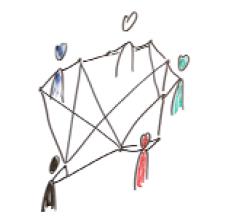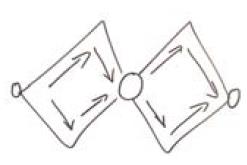Manifesto for agile quality management9 | 02 | 17
In dynamic markets and in turbulent conditions, agility is a tried and tested means of ensuring profitability. Agility means creating and implementing solutions and products by reacting rapidly to current events, and proactively to what is anticipated for the future, whilst working in autonomous and interactive networks. Traditional quality management came into being in stages and entered its mature phase when organisations were much more stable or considered to be so – which means that traditional quality management can no longer meet the needs of the agile and active organisations of today. This is damaging, as it means that quality management is losing acceptance and is no longer so effective, leading to possible reductions in product quality. Today, we need agile quality management.
The Manifesto for Agile Software Development has initiated a great leap forward in making organisations more agile, not only in relation to software developers, but increasingly in other sectors also. Methods such as Scrum and Design Thinking are proving transformational within corporate culture and are helping to push forward the agility agenda. It is now time to consider how quality management can be regenerated in order to support agile corporate cultures and structures. A first step is the formulation of agile principles following on from ISO 9001. This provides an important basis for discussion, comment and augmentation by the Expert Group.
Customer interaction
Traditional quality management recognises the importance of the customer. It asks for customer requirements and works on satisfying them. In extreme cases, there are only two points of contact; one when asking for the requirements and a second when establishing if the customer is satisfied.
 Agile quality management seeks and manages continual interaction with today’s
Agile quality management seeks and manages continual interaction with today’s
customers and the potential customers of tomorrow. In close association with the
basic principle of iteration, the organisation actively involves customers or suitable
representatives of large target groups at the different stages of idea generation,
development, realisation and use of products.
Servant leadership
Traditional quality management is tailormade for very hierarchical organisations. However, agile organisations are to a large extent self-organising.
In agile organisations, hierarchies are melting away. Interdisciplinary teams are taking over decisive roles and tasks which were previously occupied or allocated by managers.
 Competence, communication and effective networking in and between teams are the characteristics of agile organisations which enable extremely rapid reaction with high- quality results. Servant leadership provides the resources and structures that are needed for this and creates a supportive culture in the organisation. The agile team then assigns responsibilities as the situation requires.
Competence, communication and effective networking in and between teams are the characteristics of agile organisations which enable extremely rapid reaction with high- quality results. Servant leadership provides the resources and structures that are needed for this and creates a supportive culture in the organisation. The agile team then assigns responsibilities as the situation requires.
Interdisciplinary networking
Traditional quality management has typically understood involvement of people to mean involvement of experts who have a defined range of competencies and authorities.
 Interdisciplinary networking draws its effectiveness from a high degree of networking between many people both inside and outside the organisation, regardless of their function or position in the organisation chart. Agile Teams know the people they need and involve them accordingly. Such activity can hardly be planned or controlled. Agile quality management must both stimulate and support networking.
Interdisciplinary networking draws its effectiveness from a high degree of networking between many people both inside and outside the organisation, regardless of their function or position in the organisation chart. Agile Teams know the people they need and involve them accordingly. Such activity can hardly be planned or controlled. Agile quality management must both stimulate and support networking.
Evolutionary approach
The process approach of traditional quality management is a powerful tool – for process-based organisations. Project-based organisations and agile organisations have additional needs that have to be fulfilled in order to supply high quality to their customers.
 The evolutionary approach of agile quality management means constantly rediscovering the balance between the process approach, traditional project management and agile working practices within an evolutionary environment, and developing a culture that promotes agility. It supports continual transformation and makes it possible to face upheaval and sudden change.
The evolutionary approach of agile quality management means constantly rediscovering the balance between the process approach, traditional project management and agile working practices within an evolutionary environment, and developing a culture that promotes agility. It supports continual transformation and makes it possible to face upheaval and sudden change.
Iteration
One of the strongest images within traditional quality management is the PDCA wheel rolling up a slope, with continual improvement forming a wedge which prevents it from rolling back down again. But in this model, there is no turning back.
 Iteration means always returning to the point where a solution or improvement can actually be identified or is more readily possible. The iterative approach to agile quality management is well able to deal with failure, and is very experimental. It produces totally new solutions again and again.
Iteration means always returning to the point where a solution or improvement can actually be identified or is more readily possible. The iterative approach to agile quality management is well able to deal with failure, and is very experimental. It produces totally new solutions again and again.
Crunch point based solutions
The evidence- or fact-based decisionmaking of traditional quality management is often mere wishful thinking. For in most cases, there are simply not enough facts or they are consciously ignored or moulded so as to achieve a desired result. The conclusion then appears more scientific than it really is.
 What we really need is solutions, not decisions. Evidence, facts, understanding and observation are of course very important for finding solutions. But the most important factor in agile quality management is to find the decisive crunch point which identifies the design challenge which can lead to a fantastic result.
What we really need is solutions, not decisions. Evidence, facts, understanding and observation are of course very important for finding solutions. But the most important factor in agile quality management is to find the decisive crunch point which identifies the design challenge which can lead to a fantastic result.
Human centricity
Relationship management is a leading principle of traditional quality management, which recognises the importance of relationships with the stakeholders of the organisation.
 Organisations with agile quality management focus totally on the needs of people within all interest groups, want to understand their quality needs at all times and use this understanding to create quality in all its relevant aspects.
Organisations with agile quality management focus totally on the needs of people within all interest groups, want to understand their quality needs at all times and use this understanding to create quality in all its relevant aspects.
Author: Benedikt Sommerhoff and DGQ Expert Group for Quality Management & Organisation Development
If you wish to comment or contact the author: bs@dgq.de


Comments are closed.